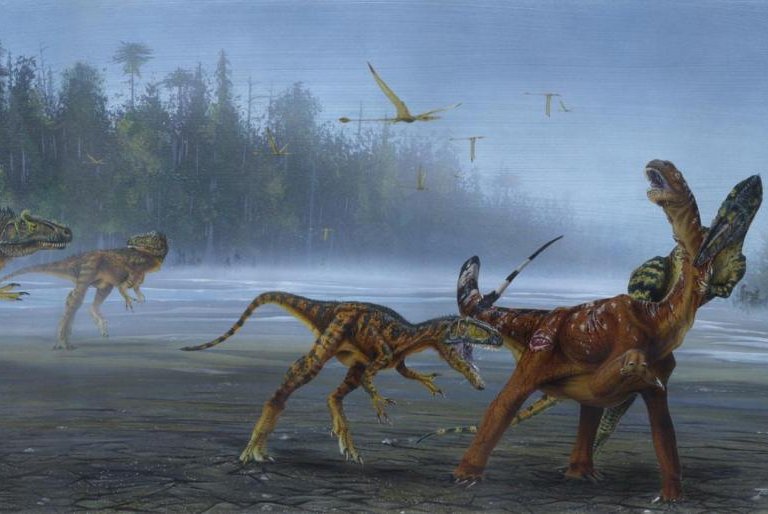1 of 2 | An illustrations shows a group of Allosaurus jimmadseni dinosaurs swarming a juvenile sauropod. Photo by Todd Marshall
Jan. 24 (UPI) -- More than two decades after a unique two-legged carnivore was unearthed in Utah's Dinosaur National Monument, scientists have given the massive carnivore a name. Scientists announced the newly named Allosaurus jimmadseni in the journal PeerJ on Friday.
The new species, which lived 155 million years ago in what's now Colorado, Utah and Wyoming, is a member of a group of dinosaurs called allosauroids.
Some allosaurs were small and some were extremely large, but they all walked on two legs and ate meat. The group thrived throughout the Jurassic and Cretaceous periods.
The skull and facial features of Allosaurus jimmadseni set the species apart from its relatives. Low facial crests extended from the dinosaur's horns, arcing just in front the eyes stretching down the length of its nose. The back of the allosaur's head was relatively narrow and its skull was weaker. Allosaurus jimmadseni would have had less of an overlapping field of vision than closest relative Allosaurus fragilis.
The diversity of allosaurs in North America is an oft debated topic among paleontologists. Some scientists content there were as many as 12 species. The latest study recognizes only the previously mentioned two.
"Previously, paleontologists thought there was only one species of Allosaurus in Jurassic North America, but this study shows there were two species -- the newly described Allosaurus jimmadseni evolved at least 5 million years earlier than its younger cousin, Allosaurus fragilis," study co-author Mark Loewen, research associate at the Natural History Museum of Utah and associate professor geology and geophysics at the University of Utah, said in a news release. "The skull of Allosaurus jimmadseni is more lightly built than its later relative Allosaurus fragilis, suggesting a different feeding behavior between the two."
Researchers continue to scour North America's Morrison Formation for additional evidence of allosaur diversity.
"Many more exciting fossils await discovery in the Jurassic rocks of the American West," said study co-author Daniel Chure, retired paleontologist at Dinosaur National Monument.
The Allosaurus jimmadseni specimen on display at the Natural History Museum of Utah was initially discovered in 1990. In 1991, paleontologists found a second specimen, dubbed Big Al, in Jurassic deposits in Wyoming. Big Al is currently housed at the Museum of The Rockies in Bozeman, Mont.
"This exciting new study illustrates the importance of continued paleontological investigations on public lands in the West. Discovery of this new taxon of dinosaur will provide important information about the life and times of Jurassic dinosaurs and represents another unique component of America's Heritage," said Brent Breithaupt, regional paleontologist with the Bureau of Land Management.















